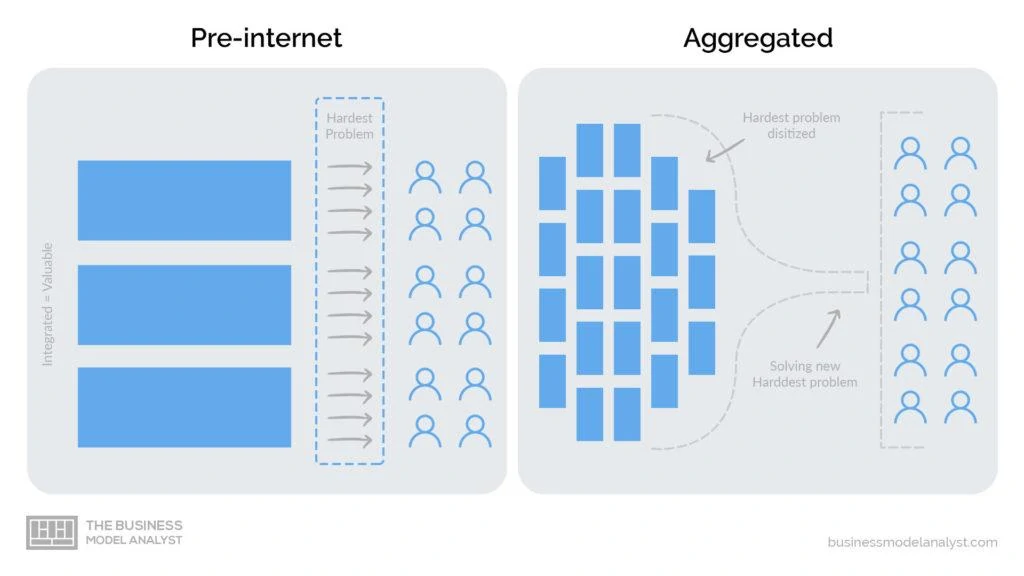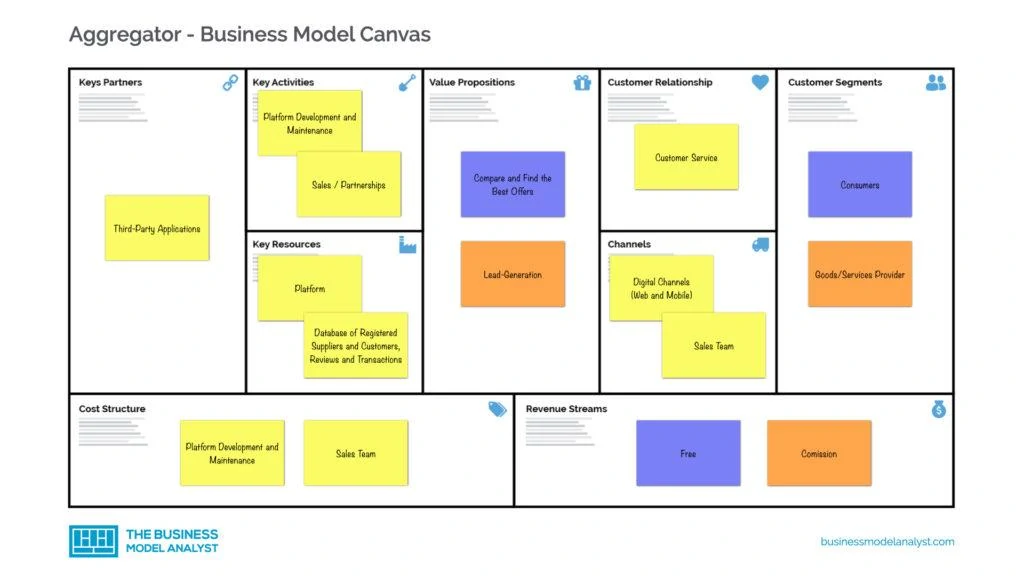The aggregator business model has come to disrupt every industry. This model, frequently confused with other kinds of platforms, usually involves organizing, under one brand, a very populated sector, such as taxis, hotels, travel, groceries, food, and more. To make it simple, the aggregator may act as a sort of middleman, but unlike other platforms, it keeps tight control of the entire experience of its users. This was also enabled by the internet. The fundamental disruption of the Internet has been to turn the traditional value-chain on its head. First, the Internet has made distribution (of digital goods) free, neutralizing the advantage that pre-Internet distributors leveraged to integrate with suppliers. Secondly, the Internet has made transaction costs zero, making it viable for a distributor to integrate forward with end users/consumers at scale.

chart by stratechery.com This has fundamentally changed the plane of competition: no longer do distributors compete based upon exclusive supplier relationships, with consumers/users an afterthought. Instead, suppliers can be commoditized leaving consumers/users as a first-order priority. By extension, this means that the most important factor determining success is the user experience: the best distributors/aggregators/market-makers win by providing the best experience, which earns them the most consumers/users, which attracts the most suppliers, which enhances the user experience in a virtuous cycle. Google
- Previously, publishers integrated publications and articles. Google modularized individual pages and articles, making them directly accessible via search
- Google integrated search results with search and profile data about users, enabling it to sell highly effective advertising
Facebook (and Ad Networks)
- Previously, publishers integrated content and advertisements. Facebook modularized advertisements by allowing advertisers to target customers directly, not via proxy
- Facebook integrated News feed ad inventory and profile data, enabling it to sell highly effective advertising
Amazon
- Previously, book publishers integrated editing, marketing and distribution. Amazon modularized distribution first via e-commerce and then via e-books
- Amazon integrated customer data and payment information with e-book distribution and its Amazon publishing initiative (the framework is clearest when it comes to books, but the integration of distribution and the customer relationship also applies to most of Amazon’s business)
Netflix
- Previously, networks integrated broadcast availability and content purchases. Netflix modularized broadcast availability by making its entire library available at any time in any order
- Netflix integrated content purchases and customer management, enabling a virtuous cycle of increased subscription demand and increased content purchase capability
Uber
- Previously, taxi companies integrated dispatch and fleet management. Uber modularized fleet management by working with independent drivers
- Uber is integrating dispatch with customer management, enabling it to scale worldwide
Airbnb
- Previously, hotels integrated vacant rooms and trust (via brand). Airbnb modularized vacant properties by building a reputation system for trust between hosts and guests
- Airbnb is integrating property management and customer management, enabling it to scale worldwide
Let’s understand how this business model work, in more detail.
Contents
What is an Aggregator Business Model?
It is a networking e-commerce business model where this firm, known as an aggregator, brings together, at one place, information and data about a particular good or service offered by several competing providers. The aggregator makes the providers its partners, and sell their services or products under its own brand. The providers will never become aggregator’s employees. They’ll continue to be the owners, but sign a contract with the aggregator. The aggregator almost always doesn’t have any manufacturing structure or warehouse. It relies on its capability of marketing its partners in a win-win way, by creating a single domain which offers uniform quality and price, providing convenience to users.
Aggregator Business Model Canvas
Let’s take a look at how the aggregator business model can be designed on the business model canvas

Aggregators’ features
- All the goods or services come from the same industry. They are just organized under one only brand.
- The partners are never employees. They can accept or reject the aggregator’s proposal.
- The customers are not only the users, who will buy the services of the partners. But the partners themselves, as the aggregator has to offer advantages for them to choose using this platform rather than others.
- Most of the revenue is invested in developing and marketing a brand. This brand has to mean quality, trust, price, anything that can attract both partners and users.
- The quality of service/good must be standardized, so the contracts demand that all the providers make sure to provide a certain level of quality.
- The contract signed between aggregator and provider involves a win-win strategy where both parties are benefited by offering standardized quality.
How does the Aggregator Business Model work?
Well, the sequence of steps is kind of simple:
- Aggregator gets in contact with the provider, offering a partnership plan.
- Providers and aggregator sign up contracts, becoming partners.
- Aggregator creates a network of partnerships.
- Aggregator invest in a great marketing strategy to empower its brand.
- Users attracted by aggregator’s promises buy through its platform.
- Partners get their customers and aggregator, its commission.
How does an Aggregator make money?
As mentioned above, the revenue streams of the aggregator are the commissions. Because, as the aggregator provides the customers to the partners, then the partners pay a percentage of their earnings. For that, the partners quote a minimum price and the aggregator will quote the total price to the final consumer. The revenue can vary according to the industry, but also to the season, the place, etc.
The value proposition of an Aggregator
The value proposition to the final customer, the buyer, can be summarized in time, money, convenience and safety. It’s much more convenient for the users to just browse one website, for example, and be able to compare prices. The aggregator also increases the possibility of finding the best offer, and the customer can feel safer by checking the rating and reviews about the providers. Regarding to the partners, the value proposition is reducing business costs. They only pay when they earn. And they don’t have to invest on all of the infrastructure of the business or on marketing.
Aggregator Business Model Vs Marketplace Business Model
There are many similarities between both business models and that’s why they are often mistaken. Both aggregators and marketplaces connect vendors and buyers together on a common platform, and service is nearly the same. Nevertheless, some differences can be easily identified, as follows:
- Aggregator doesn’t make users interact freely on the platform. In other words, it doesn’t only enable the connection between both sides. On the contrary, it’s the aggregator that keeps interacting with the parties involved. It actually has tight control over the whole transaction.
- A marketplace, on the other hand, has basically a platform where it allows sellers to promote their goods or services. It’s a species of middleman between buyer and seller.
- An aggregator has a network of partners organized under a big umbrella of its own brand. All services/goods are provided under the same name.
- In a marketplace, the providers are responsible for all the product details, its quality, its price, shipping process, etc.
- Aggregator organizes the different providers under one standard. The terms and conditions, including prices, are all defined during the contract.
Types of Aggregators
Some of the most common aggregators are:
- Content: they aggregate news and updates from several online sources.
- Job: they aggregate job postings from various career sites and employer listings.
- Poll: they aggregate poll results conducted by different organizations to estimate public opinion.
- Real estate: they aggregate real estate listings from several sources, making property details and prices available.
- Review: they aggregate reviews of the entertainment business, such as books, games, TV shows, or films.
- Search: they are the metasearch engines that aggregate results from many search engines.
- Social network: they are websites that aggregate content from various networking websites.
- Shopping: they aggregate results from different shopping engines, displaying price and rating comparisons.
- Video: they aggregate video content from several websites and categorize them into lists.
The bottom line
It’s very common to think that the aggregator business model has been born in the digital world, because the internet has given scalability to the business (think about Uber or Airbnb) and has made all the processes much easier, from payment to shipping. However, the aggregator business model is prior to the internet. There were many companies in the music industry, for example, that controlled artists and CD production (and that is not so far from today). In spite of that, the digital age has turned the aggregator into a disruptive business model, capable of changing the way we do business in any kind of industry. Just be there and watch it!

